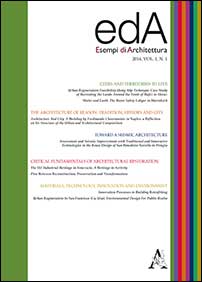Estratto da
ESEMPI DI ARCHITETTURA
International Journal of Architecture and Engineering
Pisa between reconstruction, preservation and transformation
ESEMPI DI ARCHITETTURA
International Journal of Architecture and Engineering
Pisa between reconstruction, preservation and transformation

The urban structure of the city of Pisa at the beginning of the twentieth century suffered a lot of developments determined by two master plans of nineteenth century, the Plan of “beautification and enhancement” of Silvio dell'Hoste in 1852 and the Plan of Vincenzo Micheli in 1871. In 1929 was launched a competition for architects and engineers for the new Master Plan of Pisa and Marina di Pisa: the jury was composed by Gustavo Giovannoni, Corrado Ricci, Ghino Venturi, Pietro and Francesco Cuppello Bernieri. The presence of Giovannoni at the head of the Commission was a guarantee for a plan that didn’t propose the demolition of the historic tissue, but only urban "thinnings". The Master Plan of 1929 for Pisa planned several operations in the urban and extra-urban territory, paying particular attention to the identity preservation of the places. The events that followed the approval of the plan changed many of the points dictated by Gustavo Giovannoni, disregarding also the programming indicated by the designers winners of the competition for the Plan. The World War II, that affected the whole of Italy, directly struck at the heart of some of the most significant places of the city. The situation emerged in Pisa after the bombing of the 31 August 1943 required a master plan entrusted to the engineers Luigi Pera, Ugo Ciangherotti e Giulio Fascetti and to the architect Renzo Bellucci. The guidelines for the reconstruction of the Arno River and the historic quartiers of the city were based on compliance with the existing urban tissue, in close collaboration with the Superintendent of Monuments, Piero Sanpaolesi: he worked in the urgency for the reconstruction, the recognition and preservation of historic buildings of the city. Despite the efforts of Sanpaolesi, reconstruction and new constructions built in historic area, didn’t have relation with the existing, either in terms of architectural style or of the materials used.
| pagine: | 53-62 |
| DOI: | 10.4399/97888548734146 |
| data pubblicazione: | Luglio 2014 |
| editore: | Aracne |








